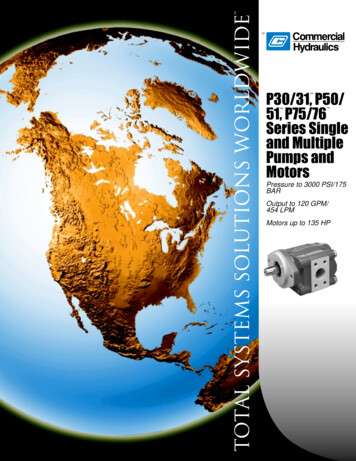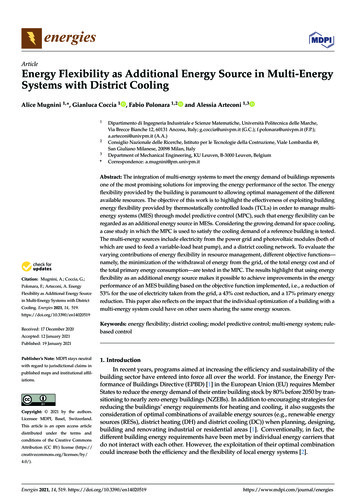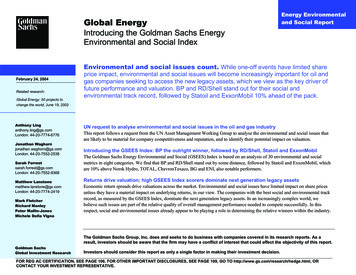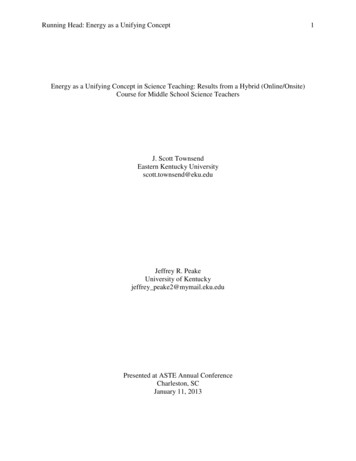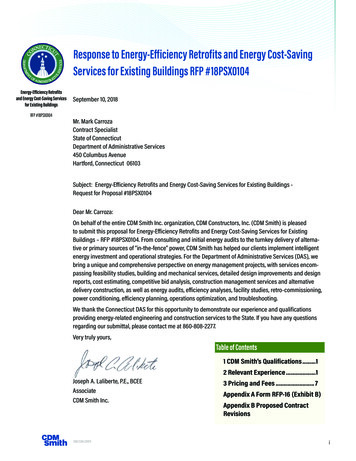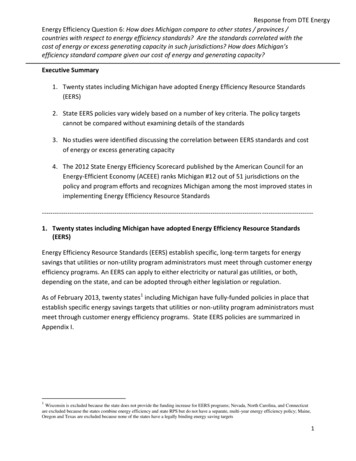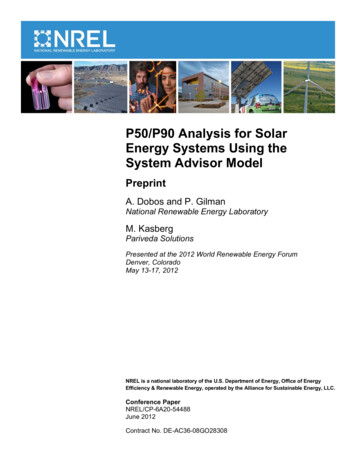
Transcription
P50/P90 Analysis for SolarEnergy Systems Using theSystem Advisor ModelPreprintA. Dobos and P. GilmanNational Renewable Energy LaboratoryM. KasbergPariveda SolutionsPresented at the 2012 World Renewable Energy ForumDenver, ColoradoMay 13-17, 2012NREL is a national laboratory of the U.S. Department of Energy, Office of EnergyEfficiency & Renewable Energy, operated by the Alliance for Sustainable Energy, LLC.Conference PaperNREL/CP-6A20-54488June 2012Contract No. DE-AC36-08GO28308
NOTICEThe submitted manuscript has been offered by an employee of the Alliance for Sustainable Energy, LLC(Alliance), a contractor of the US Government under Contract No. DE-AC36-08GO28308. Accordingly, the USGovernment and Alliance retain a nonexclusive royalty-free license to publish or reproduce the published form ofthis contribution, or allow others to do so, for US Government purposes.This report was prepared as an account of work sponsored by an agency of the United States government.Neither the United States government nor any agency thereof, nor any of their employees, makes any warranty,express or implied, or assumes any legal liability or responsibility for the accuracy, completeness, or usefulness ofany information, apparatus, product, or process disclosed, or represents that its use would not infringe privatelyowned rights. Reference herein to any specific commercial product, process, or service by trade name,trademark, manufacturer, or otherwise does not necessarily constitute or imply its endorsement, recommendation,or favoring by the United States government or any agency thereof. The views and opinions of authorsexpressed herein do not necessarily state or reflect those of the United States government or any agency thereof.Available electronically at http://www.osti.gov/bridgeAvailable for a processing fee to U.S. Department of Energyand its contractors, in paper, from:U.S. Department of EnergyOffice of Scientific and Technical InformationP.O. Box 62Oak Ridge, TN 37831-0062phone: 865.576.8401fax: 865.576.5728email: mailto:reports@adonis.osti.govAvailable for sale to the public, in paper, from:U.S. Department of CommerceNational Technical Information Service5285 Port Royal RoadSpringfield, VA 22161phone: 800.553.6847fax: 703.605.6900email: orders@ntis.fedworld.govonline ordering: http://www.ntis.gov/help/ordermethods.aspxCover Photos: (left to right) PIX 16416, PIX 17423, PIX 16560, PIX 17613, PIX 17436, PIX 17721Printed on paper containing at least 50% wastepaper, including 10% post consumer waste.
WREF 2012: P50/P90 ANALYSIS FOR SOLARENERGY SYSTEMS USING THE SYSTEMADVISOR MODELAron P. DobosStrategic Energy Analysis CenterNational Renewable Energy LaboratoryPhone: 303.384.7422Email: aron.dobos@nrel.govMichael KasbergIT ConsultantPariveda SolutionsDenver, COPaul GilmanTechnical Consultant to theNational Renewable Energy LaboratoryPortland, ORTo secure competitive financing for a solar energy gen eration project, the economic risk associated with interannual solar resource variability must be quantified. Oneway to quantify this risk is to calculate exceedance probabil ities representing the amount of energy expected to be pro duced by a plant. Many years of solar radiation and metere ological data are required to determine these values, oftencalled P50 or P90 values for the level of certainty they repre sent. This paper describes the two methods implemented inthe National Renewable Energy Laboratory’s System Advi sor Model (SAM) to calculate P50 and P90 exceedance prob abilities for solar energy projects. The methodology and sup porting data sets are applicable to photovoltaic, solar waterheating, and concentrating solar power (CSP) systems.1IntroductionThe economic value of a solar energy generating facilitydepends on the availability of the solar resource. The so lar radiation, and to a lesser extent, temperature, humidity,atmospheric pressure, and wind speed determine the timingand quantity of energy the facility generates. Weather-relatedevents such as passing clouds or storms introduce resourcevariability at short time scales, and larger-scale events suchas volcanic eruptions and climate cycles introduce variabil ity on larger, inter-annual time scales. In their assessment ofthe value of a solar energy project, financial institutions usestatistical methods to determine the likelihood that a powerplant will generate a certain amount of energy in any givenyear over the plant’s 20- to 30-year life.Exceedance probabilities have been widely used in thewind industry to describe the probability that a particular lo cation will experience sufficient wind speeds for a proposedwind farm to be financially sound. Banks and investmentfirms working on wind farm projects often require P50 andP90 values of the wind resource at a location to determinethe risk associated with a project’s ability to service its debtobligations and other operating costs. Although the solar re source is generally more predictable than wind [7], the ex ceedance probability risk assessment approach can also beapplied to solar energy projects.Statistically robust estimates of energy generation ex ceedance probabilities require many years of resource data,as well as sufficiently detailed system performance models.The System Advisor Model (SAM) is a free software appli cation produced by the National Renewable Energy Labora tory that performs rigorous solar power plant system perfor mance modeling and calculates detailed financial cashflows.SAM calculates metrics such as annual energy output, capac ity factor, levelized cost of electricity (LCOE), internal rateof return (IRR), and others for flat-plate and concentratingphotovoltaic generators, as well as various configurations ofconcentrating solar power (CSP) systems including parabolictrough, power tower, dish stirling, and linear Fresnel, withand without thermal energy storage (as applicable).This paper describes SAM’s P50/P90 analysis capabil ity, starting with the available long-term weather datasets,details of the calculation methods for P50 and P90, and ex plores two representative analysis scenarios for a utility scaleflat-plate PV system and a solar power tower system.2 Solar Radiation and Weather DataSome solar energy simulation software use files from theTypical Metereological Year (TMY) datasets [1, 2] as input.TMY files are available for many locations in the UnitedStates, making them suitable for use in simulation models1
like SAM. The TMY2 and TMY3 datasets consist of a file foreach location, and each file contains hourly data derived fromlong term measured data. The data are processed by choos ing ”typical” months to represent the long term properties ofthe data. Data representing months during outlier events suchas large volcanic eruptions are excluded to ensure that the filerepresents the long-term climate. For project financial anal ysis, these outlier events may result in worst-case years thataffect the project’s financial terms. Because the TMY files donot include data from these potential worst-case years, theymay be more appropriate for preliminary analysis of a systemdesign than for financial decisions. Using multi-year histori cal data to model the long term performance of a system in stead of a TMY file ensures that the performance predictionaccounts for potential worst case years [6].The National Solar Radiation Database (NSRDB) is along term hourly dataset of measured and modeled solar ra diation for hundreds of locations in the United States. Eachlocation in the database may have hourly records from 1961 1990, or 1991-2005, or both, meaning that some locationshave a full 45 years of data. While solar radiation is the pri mary driver of a PV or CSP plant’s energy projection, me tereological weather data (temperature, pressure, humidity,etc) also have secondary but not insignificant impacts on asystem’s performance. The National Climatic Data Center(NCDC) maintains a corresponding database of the metero logical inputs required by the SAM models, and can be ob tained with the solar radiation data for a nominal fee. Tomake robust P50/P90 analysis available to a wider audience,NREL partnered with the NCDC to make the dataset avail able without charge in an encrypted form specially designedfor use in SAM. While the raw data is not accessible to theuser, simulations can be performed using the dataset directlyin SAM.The long term NCDC/NSRDB dataset includes the im pact of large volcanic activity and other phenomena that oc cur on timescales larger than one year. In particular relevanceto solar plants, the eruption of Mt. Pinatubo introduced largequantities of aerosols into the atmosphere that reduced inci dent irradiance levels between 1991 and 1993. Other varia tions include the cyclic El Ni no and La Ni na phenomena, aswell as the 11 and 22 year sun spot cycles.3 MethodologyAn exceedance probability is the probability that a cer tain value will be exceeded. For example, a P50 value of10,000 kWh for the annual output of a solar power systemmeans that there is a 50 % likelihood that the system’s out put will be greater than 10,000 kWh. Similarly, a P90 valueof 10,000 kWh would mean that the system is likely to gener ate over 10,000 kWh 90 % of the time. [6, 7]. For analysis ofsolar energy power plants, the P50 and P90 values of annualannual electricity generation and of the LCOE can both pro vide useful information for financial analysis of a proposedproject.One method of calculating exceedance probabilities isto fit the dataset to a standard probability distribution, andto calculate the P50 or P90 value from the distribution’s cu mulative distribution function (CDF). This method is usedby [3, 8] and works well when the data is normally dis tributed. In this case, the P50 value is by definition the meanvalue µ. The P90 value can be calculated from the CDF ofa normal distribution, which is defined by the function inEqn. 1.Φx µσ 1x µ 1 1 erf2σ2(1)The P90 value occurs when Φ((x µ)/σ) 0.1. Defin ing γ (x µ)/σ, Eqn. 2 can be solved numerically.Φ(γ) 0.1 γ 1.282 x µσ(2)Rearranging terms results in Eqn. 3, which is an expres sion for the P90 value given the mean (µ) and standard devi ation (σ) of a dataset that is assumed to fit a normal distribu tion.x µ 1.282σ(3)A second method works best when the data are not nor mally distributed, as is the case with solar resource data overmany years [7], where outlier events such as volcanic erup tions and cyclic solar patterns can skew the data. In this case,no particular statistical probability distribution is assumed tofit the data, and rather an empirical CDF of the data is used tocalculate the P50 and P90 values. The empirical CDF is de termined by sorting the data in ascending order, and assign ing each data point an equal fraction of the total probability,which is equal to one. The estimation procedure is shown inTable 1 for a very small 5 point data set.Data ValueEstimated ble 1.Example Empirical CDF CalculationIt is clear from Table 1 that many more data points arerequired to establish a representative empirical CDF curvefrom which to interpolate exceedance probabilities. Suppos ing that more that 10 values are provided, the P90 value is2
calculated by linearly interpolating the table to obtain a datavalue for which the empirical CDF would equal 0.1. Figure 1shows both the estimated CDF of the irradiance componentsin Phoenix, AZ, as well as the normal CDF calculated fromµ and σ. The plot exposes many deviations from the normaldistribution, and shows why interpolating exceedance prob abilities directly from the empirical CDF is a more reliableapproach, provided the dataset is sufficiently large. The P50and P90 points using each calculation method are plotted aswell.The P90 value calculated from the normal distributionis greater than the empirical value for all three of the solarradiation components for the 30 year Phoenix, AZ dataset.Because the data do not fit a normal distribution very closely,the empirical method likely yields a better estimate of thetrue P90 value. It is just by chance that the P90 values for thediffuse irradiance are nearly identical, since by inspection aP80 value would yield quite different results from the twomethods.SAM calculates P50 and P90 values of the annual energyoutput using both methods. It performs an hourly simulationfor each year in the dataset to calculate the system’s outputfor each year. For the first method, it calculates the CDFof the normal distribution from the mean and standard devia tion of the values, and for the second method, it calculates theempirical CDF. For both methods, SAM then determines theP50 and P90 exceedance probabilities either directly fromthe normal CDF equation or by linearly interpolating the em pirical CDF table.CDF of GHI in Phoenix, AZ1Empirical CDFNormal Dist. CDFEmpirical P50 & P90Normal Dist. P50 & P900.90.80.7CDF0.60.50.40.30.2Difference in P90 values: 1.65 %Difference in P50 values: 0.30 %0.101.82.36x 10CDF of DNI in Phoenix, AZ1Empirical CDFNormal Dist. CDFEmpirical P50 & P90Normal Dist. P50 & P900.90.80.7CDF0.60.50.40.30.2Difference in P90 values: 3.34 %Difference in P50 values: 0.75 %0.104Example ScenariosIn this section, two hypothetical solar power plant sce narios are investigated using weather data for Phoenix, Ari zona. The simulations were performed with SAM version2011.12.2.The long term datasets available in the public version ofSAM 2011.12.2 contained several years of invalid metereo logical data and prohibited some simulations from complet ing successfully or gave erroneous results. For these exam ples, files for years with problematic data were removed fromthe Phoenix 45-year dataset, so the results are based on 30years of data. The modified weather dataset is available fordownload on the SAM website [10]. Efforts are underwayat NREL to better characterize potential errors and missingdata in long term historical solar and mete
way to quantify this risk is to calculate exceedance probabil ities representing the amount of energy expected to be pro duced by a plant. Many years of solar radiation and metere ological data are required to determine these values, often called P50 or P90 values for the level of certainty they repre sent. This paper describes the two methods implemented in the National Renewable .


